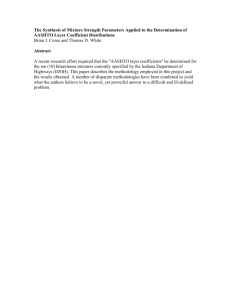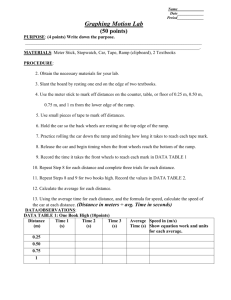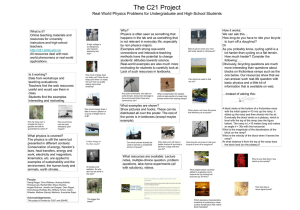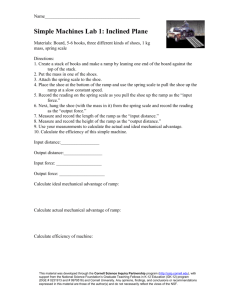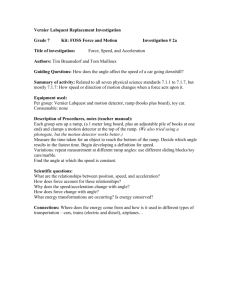2008 Region 2 Agenda - Subcommittee on Design
advertisement
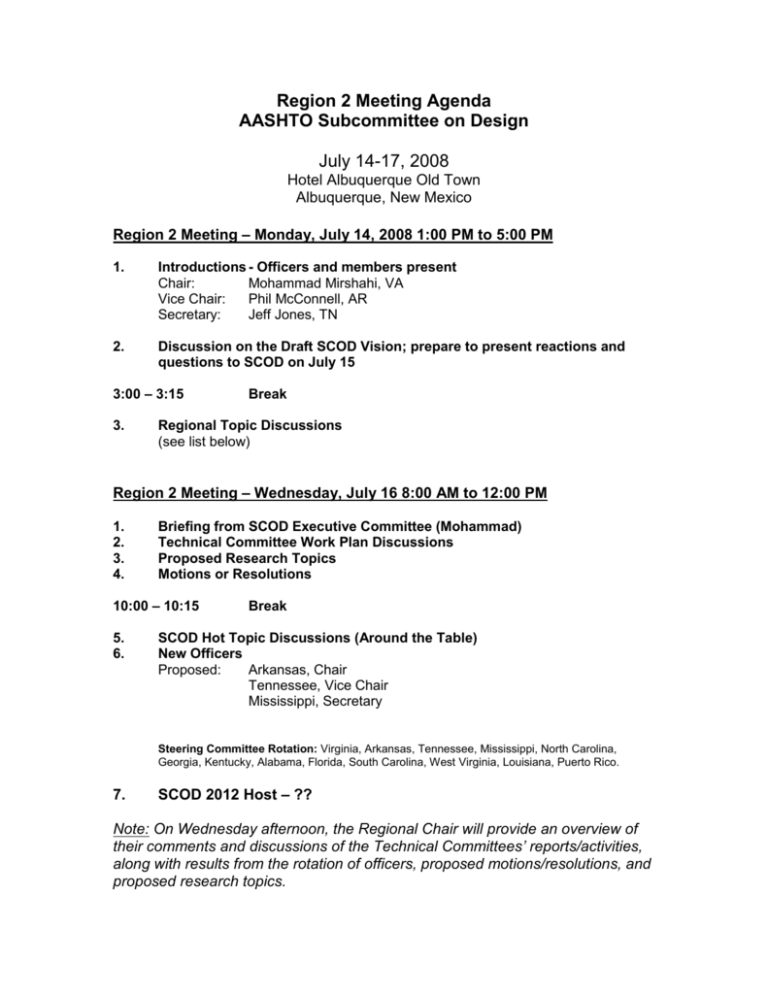
Region 2 Meeting Agenda AASHTO Subcommittee on Design July 14-17, 2008 Hotel Albuquerque Old Town Albuquerque, New Mexico Region 2 Meeting – Monday, July 14, 2008 1:00 PM to 5:00 PM 1. Introductions - Officers and members present Chair: Mohammad Mirshahi, VA Vice Chair: Phil McConnell, AR Secretary: Jeff Jones, TN 2. Discussion on the Draft SCOD Vision; prepare to present reactions and questions to SCOD on July 15 3:00 – 3:15 3. Break Regional Topic Discussions (see list below) Region 2 Meeting – Wednesday, July 16 8:00 AM to 12:00 PM 1. 2. 3. 4. Briefing from SCOD Executive Committee (Mohammad) Technical Committee Work Plan Discussions Proposed Research Topics Motions or Resolutions 10:00 – 10:15 5. 6. Break SCOD Hot Topic Discussions (Around the Table) New Officers Proposed: Arkansas, Chair Tennessee, Vice Chair Mississippi, Secretary Steering Committee Rotation: Virginia, Arkansas, Tennessee, Mississippi, North Carolina, Georgia, Kentucky, Alabama, Florida, South Carolina, West Virginia, Louisiana, Puerto Rico. 7. SCOD 2012 Host – ?? Note: On Wednesday afternoon, the Regional Chair will provide an overview of their comments and discussions of the Technical Committees’ reports/activities, along with results from the rotation of officers, proposed motions/resolutions, and proposed research topics. Regional Topics Louisiana: 1. When adding a third lane to the median on an urban interstate, we create 2. 3. 4. 5. a 15' inside shoulder. Is this common? Have any states standardized delineating this 15' inside shoulder with pavement markers or striping (chevrons)? On 6-lane interstates, what is the use of using chevrons (raised markers) on a 1012' outside shoulder? In our state, some locations have markings on the outside shoulder and some do not. We don't have a policy. The Hydraulics Unit is located in the Road Design Section at the LADOTD. This unit is responsible for the design and/or review of all hydraulic concrete structures. With the FHWA requiring LRFD standards for design, what have other states done to handle the redesign of your standards for box culverts, catch basins, and manholes? Does anyone know of any courses that deal with the use of LRFD standards for concrete structures that are not primarily for bridges? The LADOTD normally uses safety end treatments on sidedrain and crossdrain pipe that are located in the clear zone or within the limits of horizontal clearance. These items are normally used on overlay projects or in transition areas. Because of the cost of these items, their use is being questioned on different types of projects and on funding. Does any state have a written policy on the use of safety end treatments for their roadways? 1. The Department is going to try to standardize our "S" or specialty items list. A couple of our programs, "Enhancements" for example, uses a multitude of Sitems. How have other states that have standardized their specialty items dealt with this situation? 2. Attached is a spreadsheet showing deceleration lengths from both the AASHO / AASHTO Intersection Chapters and the Grade Separations and Interchange Chapters (Column headings are termed "intersection" and "ramp" respectively). The length shown is that needed to decelerate from the design speed to a stop condition. What deceleration length does your state use in the design of turn lanes and where is it measured from and to? Deceleration length needed to stop (AASHTO Policy on Design of Highways and Streets) 1965 Rural All highways Speed mph 20 30 40 45 50 55 1973 Urban Ramp 235 325 425 315 435 1984 Intersection 1990 Ramp Intersection 2001 Ramp 160 250 370 235 315 235 315 235 315 500 435 435 435 Intersection 230 330 430 550 680 2004 Ramp 235 320 385 435 480 Intersection 170 275 340 410 485 Ramp 235 320 385 435 480 3. Does your state "pavement widen" the turning roadway portion of two lane ramps at SPUI interchanges and if so how wide do you stripe the lanes? Arkansas: 1. For notch and widening projects with curb & gutter, how are narrow areas handled when widening with asphalt? Is there a minimum width specified for widening using asphalt? Are other types of materials specified for areas narrower than the specified minimum width for asphalt? 2. How are other states handling utilities? Are the utilities moved before the project is let? Are the utilities put in the contract? Do you have a “hammer” to force the utility companies to move in a timely manner? 3. Are other states offering both asphalt and concrete pavement sections as alternates for bids? If so, on what types of projects? Are life-cycle cost adjustments applied to bids? What are your experiences? 4. How is undercut handled on projects? Is an extensive soil survey done during plan preparation and undercut locations shown on plans? What type of backfill is specified in undercut areas? Is undercut a separate pay item? 5. It seems that some contractors have difficulty with certain facets of construction that are not a problem for others. Is contractor input solicited when plans are developed, particularly as related to stage construction details? If so, how is this done? 6. Are any states using the Interactive Highway Safety Design Model (IHSDM) software? Do any of the states that use IHSDM use Inroads as your design software. If so, are there any problems of compatibility? Florida: 1. Design Platform Diversification: a. Due to ever increasing costs, FDOT is reviewing our current Design Platform (products like MicroStation and Geopak). We have been operating under a contract with the vendor for these proprietary products since the late 1970s. We are aware that several other states are looking at these costs and one is already committed to switching (Wisconsin). What costs are the other agencies being asked to contract for to renew their licenses? 2. AASHTO Greenbook Design Value Ranges: a. As many in the Region know, FDOT was charged by its Transportation Directors to review potential revisions to our design criteria to save construction and right of way costs. Our published design criteria, based on Florida conditions and the experience of our senior designers, typically took the more conservative values within the Greenbook ranges. We have completed a study of two rural arterial widening projects and determined that yes there were some minor savings in construction costs. Most of the saving realized were in right of way. However, when we looked at the safety impacts of using less conservative design values we found them to be of the same magnitude as the right of way savings. Our safety analysis was in accordance with the draft Highway Safety Manual. Have other states been asked to do similar studies of their design criteria and if so what were their results? 3. Cable Barrier Challenges: a. Florida is experiencing many seemingly region-specific challenges with cable barrier. End anchorage pull exceeds the lateral capacity of the soil they are founded in. Wasps are constructing nests in posts with a “C” channel shape. Many of our challenges are being addressed in our Developmental Specification and Design Bulletin on the topic. Are any other challenges being experienced by the states that are due to the inadequate installation of their systems or the product-specific designs? North Carolina: 1. Bridge Program Delivery 2. How long does it take from start of study (100-200 bridges annually) until the project is planned, designed, constructed and open to traffic? 3. How much does a typical local road bridge replacement project cost in today’s dollar? (right of way acquisition and construction) a. (North Carolina’s Challenge: 8000 bridges are eligible for replacement in the next 20 years (due to condition and age). 4300 are timber bridges that are 30-50 years old today.) b. North Carolina – Annually 100-150 bridge projects, start of study (begin data collection) to opening project to traffic = 6 years. North Carolina typically schedules data collection to start 5 years prior to the year construction is funded. In year 2008, we are establishing the scope of work for projects that have construction funded in the year 2011. c. Local Road Bridge Replacement - Right of way acquisition, utilities, wetland and stream mitigation costs are typically $50,000 - $500,000. Construction is typically $ 1,000,000 - $1,500,000. We currently do not construct many arch pipes or box culverts based on our adherence to environmental stewardship. 4. 3-D (Three Dimensional) Task Force a. AASHTO Committee’s did not submit enough names to establish a group and meet this year. Do you have anyone in your state that would like to work with this group? b. Three Dimensional Modeling for Highway Construction 1. NC – Charlie Brown, PE, PLS, State Location and Surveys Engineer 5) Value Engineering Proposals a. What type of proposals has your state implemented over the past two years? b. NC – 2-lane Directional Ramp at freeway to freeway interchange (3rd level) converted to a trumpet interchange with a loop (2 – level design). Potential Savings = $8,000,000-$15,000,000 (exact amount unknown at this time). This is a design-build project in which the state has not opened bids. 6) Erosion and Sedimentation Control a. Does your state have any success stories for addressing turbidity in water discharged from borrow pits? 1. NC – Water discharge from borrow pit sites shall not cause surface waters to exceed 50 NTU’s (nephelometric turbidity unit) in streams not designated as trout waters and 10 NTU’s in streams, lakes and reservoirs designated as trout waters. For lakes and reservoirs not designated as trout waters, the turbidity shall not exceed 25 NTU’s. If turbidity exceeds these levels due to the natural background conditions, the existing turbidity level shall not be increased. 7) Results Based Performance Management a. What results does your state measure at the statewide level and report to the public? 1. NC – Crash Rate, Infrastructure Health and Performance, Projects/Programs/Services on Schedule/Budget/and Scope of Work. Virginia: 1) Green Book a. Who, if anyone, has adopted the 2004 Edition of the AASHTO Green Book? If so, why was the 2004 Edition adopted by your agency and have you documented the differences between the 2001 Edition and the 2004 Edition? b. Do you have your own Design Manual? If so is it based upon the Green Book? Do you ever envision making the current version of the Green Book your DOT’s Design Manual and having your current Design Manual become a “Policy Guide/Manual”? 2) Design Speed and Posted Speed a. How are posted speed limits developed and finalized in your DOT? b. Does the road designer have input into what speed is posted based upon the design speed of the facility? c. Do you have situations where the posted speed is higher than the design speed? If so, how does your DOT view this from a “torte liability” aspect? d. How does you DOT handle “regulatory speeds” when roadways are not posted?
